A prototyping center was opened in Skolkovo, and I went to see it
On Friday, at the invitation of a friend for the first time I was in the very Ckolkovo - came to the opening of the new building and made an unexpected view of the entire project - I want to share it with you, Habr.

“Prototyping is a risky thing” by Gael Bertrand
At a two-hour speech, the launch of the prototyping corps was discussed. This is the department that will be engaged in the continuous production of prototypes with all the stuffing. The building includes four laboratories: engineering, machining, 3D-prototyping and design bureau.
But before telling more about them, I want to share my general impression - Skolkovo is really an outstanding scientific project in one visit that restored my faith in Russian science. It may sound awful, but now I’ll try to explain how I came to such conclusions.
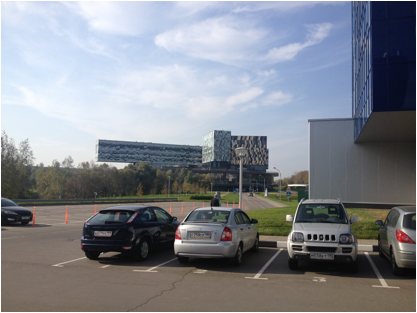
Malevich would be glad to be here.
Why is science in general flourishing in the USA and Europe, and we have a rather miserable existence here? Although in fundamental mathematics or physics we are still ahead of the rest, their applied use like programming or new electronic technologies is clearly on the side of the States. What is the catch? In the budgets.
Science is an insanely expensive and at first sight useless thing. Compare for yourselves - the expenditure of six billion on an atomic submarine can still be explained and justified, and when instead of the submarine they propose to build a one-time scientific device to test another crazy theory? And after all, every new step in science adds a few zeros to the estimate for devices.

I need those!
In 1905, Einstein proved the existence of atoms and turned over our understanding of the structure of the world. To do this, he needed several hours of reflection, an indoor aquarium and a pinch of pollen. The history of science was divided into “before” and “after” this brilliant proof - when looking through a microscope, one could see a constant “Brownian motion” of pollen, which could not be explained except by the existence of atoms.
Before Einstein, scientists had to make a choice of two main theories - either atoms are a mathematical abstraction, or real particles of matter. Today, scientists warmly recall these times of simple and understandable physics, because now they have more than two hundred serious theories of the structure of matter and no way to test at least one of them.

1964 year. The Americans intimidate the USSR with the power of their scientific thought and the first atomic aircraft carrier.
In 2012, the Large Hadron Collider reached its design capacity, and it seems that it has already achieved its main goal - to verify the existence of the Higgs boson. In scale this task is similar to the Einstein experiment and is its direct continuation, and its solution has already become as epoch-making as the “discovery of the atom”. But to solve the technical problem of the experiment, it took 27 years, more than 10,000 scientists from 100 countries and 6 billion dollars only for the construction of engineering structures. But here, the Higgs boson is found. What's next?
The present work has yet to be done - about a billion collisions will occur every second at the LHC, in each of which dozens of particles of different types will be born. The annual volume of experimental data is estimated at 10 Petabytes - LHC will give 1% of the information produced by mankind. A huge number of scientists will process this data.
And when the capacities of the LHC are exhausted, we will need a new, even more powerful collider - how do scientists straighten out such colossal amounts for their experiments? Anyone who has agreed on budgets at least once understands that this is not the most trivial task in the project. So they do not beg: the whole thing is that science in the West, attention, allocates a budget for itself.
This is precisely the secret of its success - university autonomy de facto turns science into the fifth branch of government. The university board takes part in the formation of local and federal budgets and, together with other branches of government, decides how much money will be spent on medicine, defense or, in fact, science. Naturally, for this, pundits are working to support taxpayers - they carry on propaganda campaigns and maintain an interest in their activities all the time - remember what kind of hype they raised around the collider so that its launch would not go unnoticed. In the United States, this process is especially pronounced: for example, the political (rather than administrative) career of Condoleezza Rice began in 1998 as a budget allocator for Stanford,
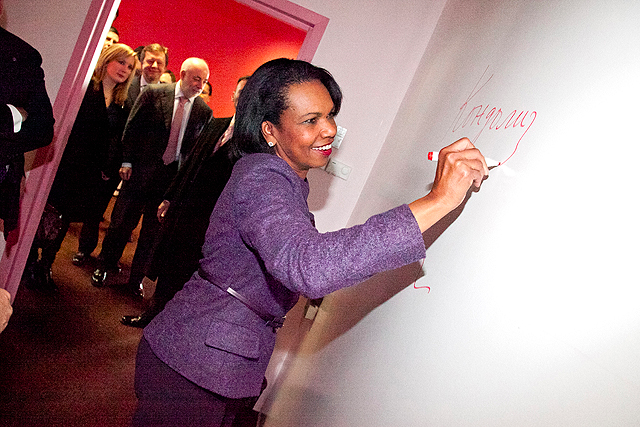
Alas, I did not find this autograph on the Skolkovo wall - I hope it hangs in a gold frame :)
It is in the return of power to scientists that Skolkovo’s idea lies - here, scientists independently distribute their budgets and decide what the future innovation center should be like. They jointly decided that they needed a prototyping center and thought out its components in detail - it turned out unexpectedly smart and productive, and at the presentation, scientists from the audience commented on all investment decisions - to which the speakers politely noticed that they were ready to consider options for the purchase of any equipment for which there will be applications from Skolkovo residents.
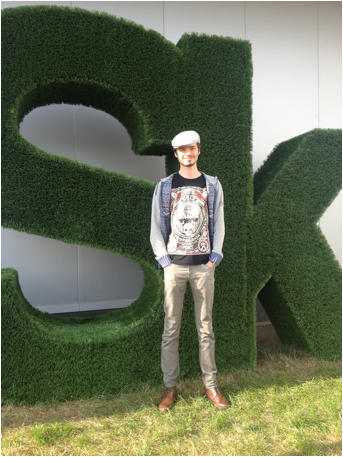
Kapitsa, by the way, also wore a cap, so here I went for my own :)
I think this is the secret of all Skolkovo's charm - these neat lawns, well-groomed parks and pretty buildings. Such a piece of super-rational Germany in the midst of a rugged Russia. What the hell is not joking, maybe this city of the future is also a big experiment to modernize the country's governance system - will they take in the next Duma and introduce an educational qualification, like in Italy at the beginning of the century, so that only trusted scientists with the rank of no lower than the professor would sit in the deputies?
It’s just completely incomprehensible to me why all this is not covered in any way, and even the inhabitants of Habr have no idea what Skolkovo is and what exactly they are doing there? Until last Friday, I was absolutely sure that this whole center of innovation - this was some kind of mediocre budget cut by moneybags from the government - until I myself saw all these young and not very scientists with burning eyes who were finally given power over science.
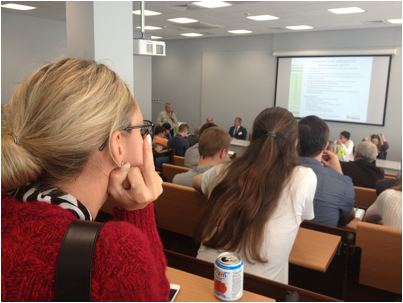
I tease Julia with a long hair from a young physicist
Hey, Vekselberg, please give them more freedom to write about their work on blogs, start a weekly column on Habré and some unofficial Twitter Skolkovo - I’m sure, like in any scientific team, there are a lot of funny things every day that could speak all Russia. Now even the rover has Twitter, where he jokes about new maps in the iPhone firmware!
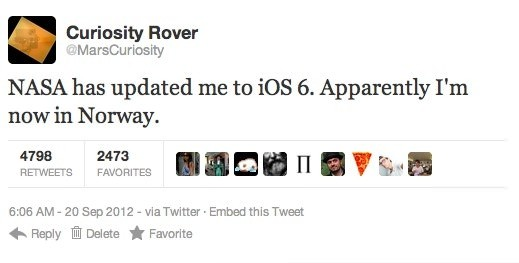
NASA updated me on iOS6. Suddenly, I am now in Norway.
Why does Skolkovo not do anything on social networks? More precisely, maybe he is doing something, but some very formal hack that no one will read in RuNet. But public support is the only thing a scientific project can rely on. Even the collider had to run viral stories about black holes and the end of the world, so that spending cyclopean budgets would not cause a negative reaction from the whole world - come on Skolkovo, be simpler and go to us! I hope that at least this post will make the Skolkovo leadership move.
But back to my adventures - what did I see with my own eyes as the first blogger (sic!) To visit the Russian silicon valley?
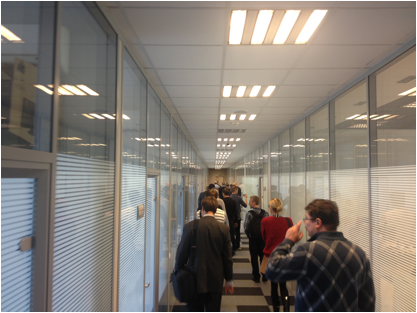
Let's go with the scientists to the laboratories - it looks like an ordinary office, only with large rooms full of all kinds of equipment.
The engineering laboratory is a branch of the defense research institute producing electronics for military needs. In the presentation, they showed their analogue of Google Glass for special forces helmets and some devices for military satellites. Skolkovo residents will contact them to develop electronics and integrated circuits for their prototypes.
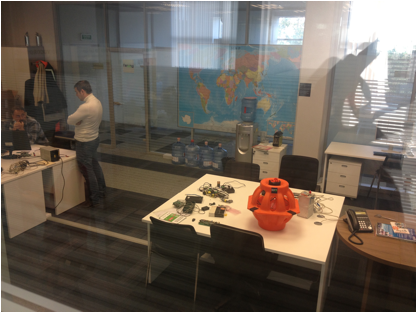
Gather the prototype of the weather satellite.
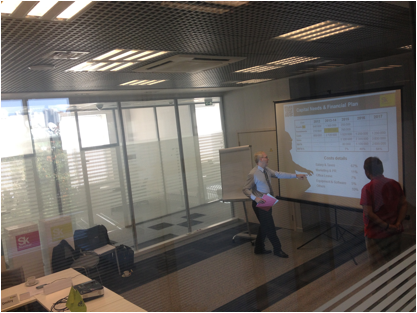
And here is the discussion of the budget by sector.
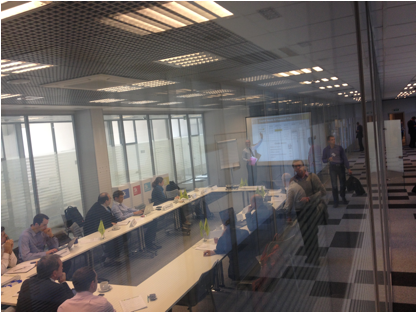
The host happily waves my hand - probably offers to attract my investments.
Machining offers all possible machines - from Soviet lathes of the 84th year to the latest in French engineering. It’s a pity I forgot to take a presentation from them, but they still haven’t uploaded it to the site.
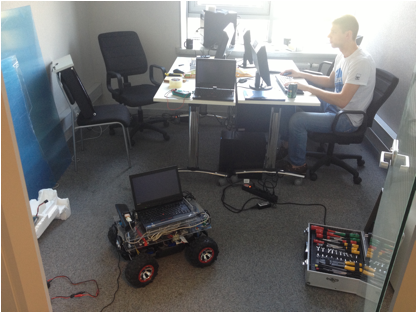
Kinekt + laptop - can this thing itself drive into the canteen for pizza?
The laboratory of 3D printers interested me the most - de facto they have a whole machine shop for the production of everything, in general everything, even if only from plastic. I, as a profane, were more interested in a German household 3D printer worth less than two thousand euros - in a couple of minutes he printed more than a decent figure.

I want the same usb printer!
I really could not resist and took out already printed legs from the printer to consider print quality - as you can see it is more than at height, the relief and folds of the surface were laid in the model - inside it is hollow with a stiffener, and between the legs there is a thin web of excess plastic - removed with a finger .
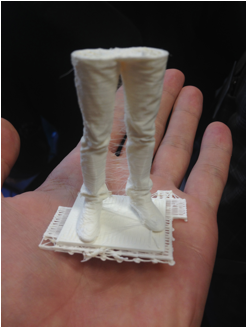
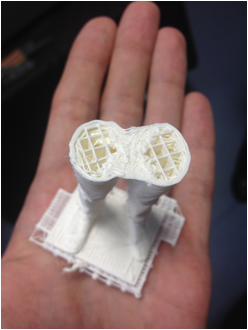
A bunch of plastic sticks for a printer costs 800 rubles, it contains 200 grams of which on average is enough for 15 prototypes, if you make them hollow inside. The accuracy of the printer is from 0.175 to 0.33, which is enough for the eyes for domestic needs. Simply put, such 3D printers are a bonanza, it’s not for you to print pictures on T-shirts - what is it like to present her miniature figurine for your girlfriend’s birthday? The prime cost is only 50 rubles.
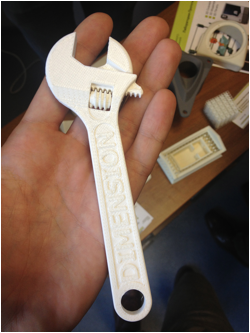
You can even print moving internal parts of any complexity - this key was printed in one pass and it works for itself.
But what you don’t expect to meet in a research center is the design department. In Skolkovo, all prototypes will go through the hands of Smirnov Design studio, as I understand it, this is the leading industrial design bureau in the country - they specialize exclusively in engineering design. About thirty minutes later, representatives of the studio explained this on the example of already completed projects.

Super chairs, already in the country's stadiums.
Most of all I liked the story with chairs for stadiums made of soft polypropylene - they had the task of making them anti-vandal, self-cleaning and at the same time weighing no more than one and a half kilograms. The task is not so difficult if it were not for polypropylene itself - it is molded by pouring and it gives a very strong tightening. That is, any fold or rib gives a furrow on the opposite side - three months of calculation and voila: a chair was born that turned this flaw into a key design element. It bends, but does not break, it is cheap but it serves for a long time, it is pleasant to sit and it is difficult to stain.
At this point, I was already hungry enough to go on a study of Skolkovo catering - but more about that sometime next time!
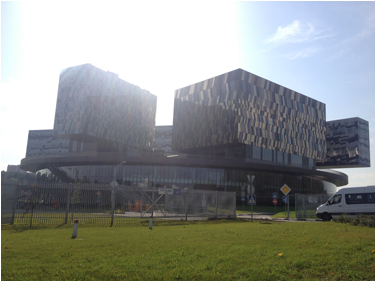
Bye, Skolkovo!

“Prototyping is a risky thing” by Gael Bertrand
At a two-hour speech, the launch of the prototyping corps was discussed. This is the department that will be engaged in the continuous production of prototypes with all the stuffing. The building includes four laboratories: engineering, machining, 3D-prototyping and design bureau.
But before telling more about them, I want to share my general impression - Skolkovo is really an outstanding scientific project in one visit that restored my faith in Russian science. It may sound awful, but now I’ll try to explain how I came to such conclusions.

Malevich would be glad to be here.
Why is science in general flourishing in the USA and Europe, and we have a rather miserable existence here? Although in fundamental mathematics or physics we are still ahead of the rest, their applied use like programming or new electronic technologies is clearly on the side of the States. What is the catch? In the budgets.
Science is an insanely expensive and at first sight useless thing. Compare for yourselves - the expenditure of six billion on an atomic submarine can still be explained and justified, and when instead of the submarine they propose to build a one-time scientific device to test another crazy theory? And after all, every new step in science adds a few zeros to the estimate for devices.

I need those!
In 1905, Einstein proved the existence of atoms and turned over our understanding of the structure of the world. To do this, he needed several hours of reflection, an indoor aquarium and a pinch of pollen. The history of science was divided into “before” and “after” this brilliant proof - when looking through a microscope, one could see a constant “Brownian motion” of pollen, which could not be explained except by the existence of atoms.
Before Einstein, scientists had to make a choice of two main theories - either atoms are a mathematical abstraction, or real particles of matter. Today, scientists warmly recall these times of simple and understandable physics, because now they have more than two hundred serious theories of the structure of matter and no way to test at least one of them.

1964 year. The Americans intimidate the USSR with the power of their scientific thought and the first atomic aircraft carrier.
In 2012, the Large Hadron Collider reached its design capacity, and it seems that it has already achieved its main goal - to verify the existence of the Higgs boson. In scale this task is similar to the Einstein experiment and is its direct continuation, and its solution has already become as epoch-making as the “discovery of the atom”. But to solve the technical problem of the experiment, it took 27 years, more than 10,000 scientists from 100 countries and 6 billion dollars only for the construction of engineering structures. But here, the Higgs boson is found. What's next?
The present work has yet to be done - about a billion collisions will occur every second at the LHC, in each of which dozens of particles of different types will be born. The annual volume of experimental data is estimated at 10 Petabytes - LHC will give 1% of the information produced by mankind. A huge number of scientists will process this data.
And when the capacities of the LHC are exhausted, we will need a new, even more powerful collider - how do scientists straighten out such colossal amounts for their experiments? Anyone who has agreed on budgets at least once understands that this is not the most trivial task in the project. So they do not beg: the whole thing is that science in the West, attention, allocates a budget for itself.
This is precisely the secret of its success - university autonomy de facto turns science into the fifth branch of government. The university board takes part in the formation of local and federal budgets and, together with other branches of government, decides how much money will be spent on medicine, defense or, in fact, science. Naturally, for this, pundits are working to support taxpayers - they carry on propaganda campaigns and maintain an interest in their activities all the time - remember what kind of hype they raised around the collider so that its launch would not go unnoticed. In the United States, this process is especially pronounced: for example, the political (rather than administrative) career of Condoleezza Rice began in 1998 as a budget allocator for Stanford,

Alas, I did not find this autograph on the Skolkovo wall - I hope it hangs in a gold frame :)
It is in the return of power to scientists that Skolkovo’s idea lies - here, scientists independently distribute their budgets and decide what the future innovation center should be like. They jointly decided that they needed a prototyping center and thought out its components in detail - it turned out unexpectedly smart and productive, and at the presentation, scientists from the audience commented on all investment decisions - to which the speakers politely noticed that they were ready to consider options for the purchase of any equipment for which there will be applications from Skolkovo residents.

Kapitsa, by the way, also wore a cap, so here I went for my own :)
I think this is the secret of all Skolkovo's charm - these neat lawns, well-groomed parks and pretty buildings. Such a piece of super-rational Germany in the midst of a rugged Russia. What the hell is not joking, maybe this city of the future is also a big experiment to modernize the country's governance system - will they take in the next Duma and introduce an educational qualification, like in Italy at the beginning of the century, so that only trusted scientists with the rank of no lower than the professor would sit in the deputies?
It’s just completely incomprehensible to me why all this is not covered in any way, and even the inhabitants of Habr have no idea what Skolkovo is and what exactly they are doing there? Until last Friday, I was absolutely sure that this whole center of innovation - this was some kind of mediocre budget cut by moneybags from the government - until I myself saw all these young and not very scientists with burning eyes who were finally given power over science.

I tease Julia with a long hair from a young physicist
Hey, Vekselberg, please give them more freedom to write about their work on blogs, start a weekly column on Habré and some unofficial Twitter Skolkovo - I’m sure, like in any scientific team, there are a lot of funny things every day that could speak all Russia. Now even the rover has Twitter, where he jokes about new maps in the iPhone firmware!

NASA updated me on iOS6. Suddenly, I am now in Norway.
Why does Skolkovo not do anything on social networks? More precisely, maybe he is doing something, but some very formal hack that no one will read in RuNet. But public support is the only thing a scientific project can rely on. Even the collider had to run viral stories about black holes and the end of the world, so that spending cyclopean budgets would not cause a negative reaction from the whole world - come on Skolkovo, be simpler and go to us! I hope that at least this post will make the Skolkovo leadership move.
But back to my adventures - what did I see with my own eyes as the first blogger (sic!) To visit the Russian silicon valley?

Let's go with the scientists to the laboratories - it looks like an ordinary office, only with large rooms full of all kinds of equipment.
The engineering laboratory is a branch of the defense research institute producing electronics for military needs. In the presentation, they showed their analogue of Google Glass for special forces helmets and some devices for military satellites. Skolkovo residents will contact them to develop electronics and integrated circuits for their prototypes.

Gather the prototype of the weather satellite.

And here is the discussion of the budget by sector.

The host happily waves my hand - probably offers to attract my investments.
Machining offers all possible machines - from Soviet lathes of the 84th year to the latest in French engineering. It’s a pity I forgot to take a presentation from them, but they still haven’t uploaded it to the site.

Kinekt + laptop - can this thing itself drive into the canteen for pizza?
The laboratory of 3D printers interested me the most - de facto they have a whole machine shop for the production of everything, in general everything, even if only from plastic. I, as a profane, were more interested in a German household 3D printer worth less than two thousand euros - in a couple of minutes he printed more than a decent figure.

I want the same usb printer!
I really could not resist and took out already printed legs from the printer to consider print quality - as you can see it is more than at height, the relief and folds of the surface were laid in the model - inside it is hollow with a stiffener, and between the legs there is a thin web of excess plastic - removed with a finger .


A bunch of plastic sticks for a printer costs 800 rubles, it contains 200 grams of which on average is enough for 15 prototypes, if you make them hollow inside. The accuracy of the printer is from 0.175 to 0.33, which is enough for the eyes for domestic needs. Simply put, such 3D printers are a bonanza, it’s not for you to print pictures on T-shirts - what is it like to present her miniature figurine for your girlfriend’s birthday? The prime cost is only 50 rubles.

You can even print moving internal parts of any complexity - this key was printed in one pass and it works for itself.
But what you don’t expect to meet in a research center is the design department. In Skolkovo, all prototypes will go through the hands of Smirnov Design studio, as I understand it, this is the leading industrial design bureau in the country - they specialize exclusively in engineering design. About thirty minutes later, representatives of the studio explained this on the example of already completed projects.

Super chairs, already in the country's stadiums.
Most of all I liked the story with chairs for stadiums made of soft polypropylene - they had the task of making them anti-vandal, self-cleaning and at the same time weighing no more than one and a half kilograms. The task is not so difficult if it were not for polypropylene itself - it is molded by pouring and it gives a very strong tightening. That is, any fold or rib gives a furrow on the opposite side - three months of calculation and voila: a chair was born that turned this flaw into a key design element. It bends, but does not break, it is cheap but it serves for a long time, it is pleasant to sit and it is difficult to stain.
At this point, I was already hungry enough to go on a study of Skolkovo catering - but more about that sometime next time!

Bye, Skolkovo!
